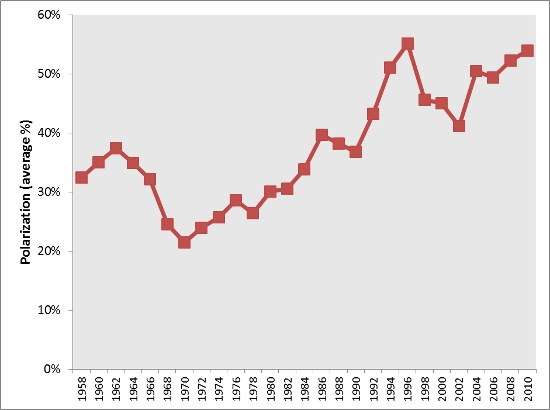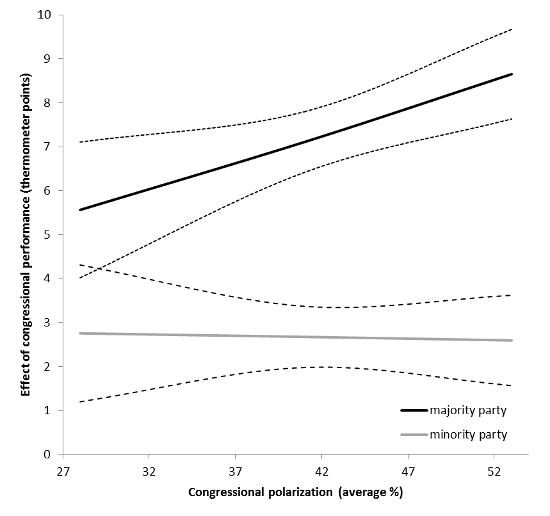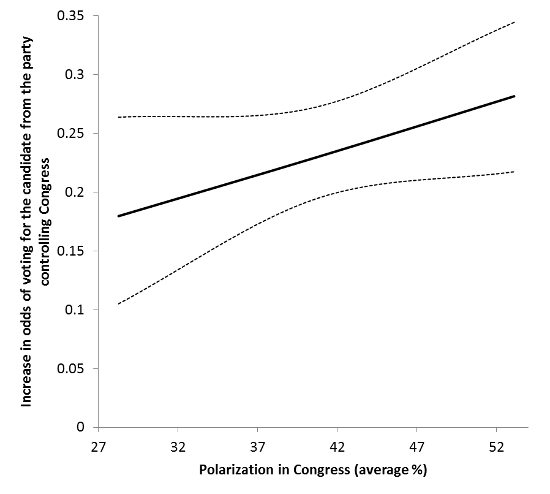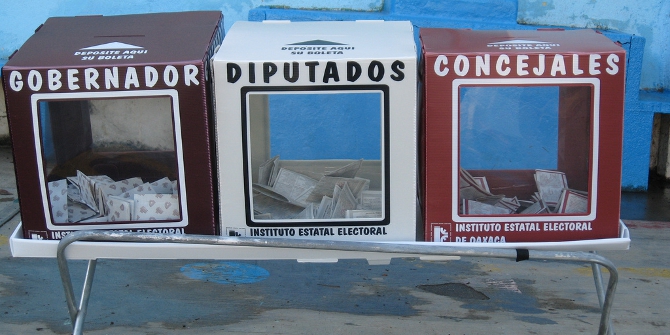 In the 2016 election cycle, President Obama’s popularity will influence the Democrats’ chances of winning, while Congress’ popularity will be important for the Republican Party, writes David Jones. In new research, he finds that in an era of high polarization in Congress, voter disapproval for the body can harm the electoral chances of the majority party – in this case the GOP – at both the national and the state level.
In the 2016 election cycle, President Obama’s popularity will influence the Democrats’ chances of winning, while Congress’ popularity will be important for the Republican Party, writes David Jones. In new research, he finds that in an era of high polarization in Congress, voter disapproval for the body can harm the electoral chances of the majority party – in this case the GOP – at both the national and the state level.
It is uncontroversial to say that as the 2016 presidential election nears, the fortunes of the Democratic Party’s nominee will be heavily influenced by the relative popularity of President Obama. What may be more surprising to learn is that the fortunes of the Republican Party’s nominee in 2016 will be significantly influenced by the relative popularity of the US Congress. In fact, not only will public attitudes towards Congress affect the race for the nation’s highest office, they will even affect thousands of state legislative contests at the local level.
In many ways, the claim that congressional performance ratings might affect any election seems strange. For several decades, conventional wisdom has held that congressional politics is too confusing for average Americans. People might disapprove of Congress’s job performance, but they are generally unable to discern who, exactly, is responsible. Therefore, low ratings of Congress are expected to have little impact on elections.
However, much of this conventional wisdom was formed during an era in which parties in Congress were relatively undifferentiated from one another in their voting. Figure 1 below shows that in 1970, the average difference between Democrats voting yes versus Republicans voting yes on roll calls in Congress was only 21 percent (four-year moving average). But by 2010, the average level of partisan difference had more than doubled to 54 percent. This increasing partisan polarization has fundamentally changed the way that the public perceives congressional politics.
Figure 1 – Partisan Polarization in Congress, 1958-2010

In an era when partisan polarization in Congress was low, actions of Congress tended to have support from members of both parties, providing the public with little sense of which party was responsible for legislative outcomes. In contrast, with greater partisan polarization in Congress, members of the majority party vote more as a unified team, opposed by the minority party. Citizens are more likely to recognize that the parties in Congress are distinct from each other, and that it is primarily the majority party that is responsible for Congress’s work product. As a result, those who dislike the performance of Congress are more likely to see this as a failing of the majority party specifically.
One way this change manifests itself is in congressional elections. For example, research shows that as polarization has increased in Congress, public disapproval of Congress has become more and more harmful for congressional candidates from the majority party.
But an even more surprising result is that the effects of public dissatisfaction with Congress can also reach beyond the narrow confines of that institution to include a party’s overall brand image in politics. In 2008, President George W. Bush’s sagging approval ratings were said to have harmed the brand of his entire party. In similar fashion, an unpopular Congress can harm the overall brand of the party that controls the legislative branch of government.
Figure 2 below illustrates the effects of congressional performance ratings on Americans’ relative warmth towards the parties, as measured on a 100-point scale. With low polarization, approving rather than disapproving of Congress makes a relatively small difference in a person’s rating of the majority party. But at the highest levels of polarization, the effect of congressional performance evaluations increases by over 50 percent. In contrast, the effect of congressional performance evaluations on ratings of the minority party hovers closer to zero, without any meaningful change as congressional partisan polarization increases. Thus with greater clarity of party differences in Congress, public disapproval of Congress is disproportionately problematic for the brand of the majority party. And, while the size of the effect of congressional approval may not seem very substantial, it is actually not too dissimilar from the much-noted effect of presidential approval on his party’s brand rating—about two-thirds as large.
Figure 2 – Polarization in Congress and the Effect of Congressional Performance Evaluations on Party Brand Favorability

How favorably citizens feel towards a party has important consequences in elections. Political psychologists find that the feelings a voter has towards a political party’s brand transfer to any political candidate running under that party label, even when voters have contradictory information about that candidate. Thus any factor that harms a party’s brand has the potential to affect all partisan elections. Because polarization increases the effect of congressional performance ratings on party brand favorability, it also increases the effect of congressional performance ratings on a variety of elections—even those outside Congress.
Figure 3 below illustrates the effect of approving of Congress on voting in presidential elections. With low polarization, approving of Congress increases the odds of supporting the presidential candidate from the same party as the congressional majority by 18 percent. With high polarization, approving of Congress increases those odds by 28 percent.
Figure 3 – Effect of Congressional Performance Evaluations, Mediated by Majority Party Favorability, on Voting for President

Similar effects are found in elections to state legislatures. The left side of Figure 4 below shows that with low levels of polarization, congressional evaluations have a negligible effect on state legislative elections. In contrast, at polarization’s peak, a ten-point increase in Congress’s job performance rating produces a 1.8-point increase in the percentage of state legislative seats held by the party in control of Congress. In fact, the effect of congressional ratings in these elections is even greater than the effect of presidential ratings.
Figure 4 – Effect of Congressional Performance Evaluations, Mediated by Majority Party Favorability, on Partisan Seat Change in State Legislatures

Given these findings, it becomes easier to understand why Republican leaders such as departing House Speaker John Boehner have vowed not to shut down the government in 2015, even though this stand is relatively controversial among rank-and-file members of his party. What Boehner understands is that avoiding actions that diminish perceptions of Congress among the general population helps preserve the overall party brand, thereby sparing electoral hardship for all candidates running as Republicans.
While there may be greater electoral incentives for the majority party in Congress to govern responsibly, the opposite is true for the minority party. If perceptions of a strong congressional performance benefit all candidates from the majority party, members in the minority have heightened motivation to obstruct and denigrate the work of Congress. In this way they can damage the electoral prospects of candidates from the opposing majority party, thereby helping their fellow partisans.
This article is based on the paper “Partisan Polarization and the Effect of Congressional Performance Evaluations on Party Brands and American Elections” in Political Research Quarterly. Thanks to Sage, this article will be ungated until the end of November, 2015.
Featured image credit: United States Government
Please read our comments policy before commenting.
Note: This article gives the views of the author, and not the position of USAPP – American Politics and Policy, nor the London School of Economics.
Shortened URL for this post: http://bit.ly/1GwaSZq
_________________________________
 David R. Jones – City University of New York
David R. Jones – City University of New York
David R. Jones is Professor of Political Science at Baruch College and the Graduate Center, City University of New York. He received his PhD from the University of California, Los Angeles. His research on congressional behavior and elections has been published in several scholarly journals. He is also the author of Political Parties and Policy Gridlock in American Government and coauthor, with Monika L. McDermott, of Americans, Congress, and Democratic Responsiveness: Public Evaluations of Congress and Electoral Consequences.






